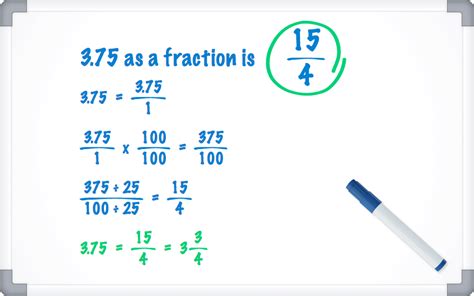What Is 3.75 As A Fraction
Kalali
Mar 25, 2025 · 4 min read

Table of Contents
What is 3.75 as a Fraction? A Comprehensive Guide
Understanding how to convert decimals to fractions is a fundamental skill in mathematics. This comprehensive guide will delve into the process of converting the decimal 3.75 into a fraction, explaining the steps involved and providing context for similar conversions. We'll explore different methods, address potential misunderstandings, and provide practice examples to solidify your understanding.
Understanding Decimals and Fractions
Before we tackle the conversion of 3.75, let's briefly refresh our understanding of decimals and fractions.
Decimals: Decimals represent numbers that are not whole numbers. They use a decimal point to separate the whole number part from the fractional part. For example, in 3.75, '3' is the whole number part and '.75' is the fractional part.
Fractions: Fractions represent parts of a whole. They are expressed as a ratio of two numbers: the numerator (top number) and the denominator (bottom number). For example, 1/2 represents one part out of two equal parts.
The key to converting decimals to fractions is recognizing that the decimal places represent powers of ten.
Converting 3.75 to a Fraction: Step-by-Step
The conversion of 3.75 to a fraction involves several simple steps:
Step 1: Write the decimal as a fraction with a denominator of 1.
3.75 can be written as 3.75/1. This step might seem trivial, but it's crucial for establishing a foundation for the next steps.
Step 2: Multiply both the numerator and denominator by a power of 10 to eliminate the decimal point.
Since there are two digits after the decimal point, we multiply both the numerator and the denominator by 100 (10 raised to the power of 2, or 10<sup>2</sup>):
(3.75 * 100) / (1 * 100) = 375/100
This step effectively moves the decimal point two places to the right, removing it entirely. The result is an improper fraction, where the numerator is larger than the denominator.
Step 3: Simplify the fraction.
375/100 is not in its simplest form. To simplify a fraction, find the greatest common divisor (GCD) of the numerator and the denominator and divide both by it. The GCD of 375 and 100 is 25.
375 ÷ 25 = 15 100 ÷ 25 = 4
Therefore, the simplified fraction is 15/4.
Step 4: Convert to a mixed number (optional).
An improper fraction (where the numerator is larger than the denominator) can be converted into a mixed number, which consists of a whole number and a proper fraction. To do this, divide the numerator by the denominator:
15 ÷ 4 = 3 with a remainder of 3.
This means that 15/4 can be written as the mixed number 3 3/4. This represents three whole units and three-quarters of another unit.
Therefore, 3.75 as a fraction is 15/4 or 3 3/4.
Alternative Method: Using Place Value
Another approach to converting 3.75 to a fraction leverages the place value system.
The number 3.75 can be broken down as follows:
- 3: Represents 3 whole units.
- .7: Represents 7 tenths (7/10).
- .05: Represents 5 hundredths (5/100).
Adding these together:
3 + 7/10 + 5/100
To combine these fractions, find a common denominator, which is 100:
3 + (7/10 * 10/10) + 5/100 = 3 + 70/100 + 5/100 = 3 + 75/100
This gives us 3 and 75/100. Simplifying 75/100 (by dividing both by 25) results in 3/4. Therefore, we again arrive at 3 3/4, which is equivalent to 15/4.
Common Mistakes to Avoid
Several common mistakes can occur when converting decimals to fractions:
- Incorrect Placement of the Decimal Point: Double-check your multiplication and division steps to ensure you're correctly handling the decimal point.
- Failing to Simplify: Always simplify your fractions to their lowest terms. Leaving a fraction unsimplified can lead to inaccuracies in calculations.
- Misunderstanding of Mixed Numbers and Improper Fractions: Remember that an improper fraction can be converted to a mixed number (and vice-versa) to represent the value in a more intuitive way.
Practice Examples
Let's apply the steps we've learned to a few more examples:
Example 1: Convert 2.25 to a fraction.
- 2.25/1
- (2.25 * 100) / (1 * 100) = 225/100
- Simplify: 225/100 = 9/4
- Mixed number: 2 1/4
Example 2: Convert 0.625 to a fraction.
- 0.625/1
- (0.625 * 1000) / (1 * 1000) = 625/1000
- Simplify: 625/1000 = 5/8
Example 3: Convert 1.8 to a fraction.
- 1.8/1
- (1.8 * 10) / (1 * 10) = 18/10
- Simplify: 18/10 = 9/5
- Mixed number: 1 4/5
Conclusion
Converting decimals to fractions is a crucial skill with wide applications. By understanding the underlying principles and following the step-by-step process outlined above, you can confidently convert any decimal to its fractional equivalent. Remember to always simplify your fraction to its lowest terms and, where appropriate, express your answer as a mixed number for clarity. Practice regularly to solidify your understanding and improve your proficiency in this essential mathematical skill. This detailed guide should equip you with the knowledge and confidence to tackle any decimal-to-fraction conversion problem you encounter.
Latest Posts
Latest Posts
-
What Percentage Is 4 Of 6
Mar 28, 2025
-
How Many Grams Is 1 5 Oz
Mar 28, 2025
-
27 Degrees C Is What In Fahrenheit
Mar 28, 2025
-
How Many Cups Are In 60 Oz
Mar 28, 2025
-
Cuanto Es 160 Grados Celsius En Fahrenheit
Mar 28, 2025
Related Post
Thank you for visiting our website which covers about What Is 3.75 As A Fraction . We hope the information provided has been useful to you. Feel free to contact us if you have any questions or need further assistance. See you next time and don't miss to bookmark.
